Galaxy Watch 3 review: The best non-Apple smartwatch
Samsung’s Tizen OS continues to shine.
Samsung has made many, many smartwatches. And through all that experience the company has refined its Tizen software so much that it’s completely ditched Google’s Wear OS. The Galaxy Watch 3 is Samsung’s latest attempt to keep up with Apple, the reigning smartwatch king, introducing familiar features like fall detection and a built-in electrocardiogram (ECG) test. But Samsung also does a few things better, like sleep tracking and just generally getting you to move. Plus, its signature rotating bezel is still a superior way to navigate a smartwatch. At $400, the Watch 3 costs the same as the Apple Watch Series 5, making it clear who Samsung sees as competition. Samsung is going for the smartwatch crown (among Android users, at least). Despite a few quirks, it turns out the Galaxy Watch 3 has potential.
Design
Samsung’s “Mystic Bronze” color for this year’s devices looks nicer on the Note 20 Ultra than on the Watch 3. The case itself has a more coppery hue, while the leather band on my review unit is closer to mauve than bronze. If you prefer something more conservative, there’s always a generic black option.
Color choice aside, the Galaxy Watch 3 is noticeably thinner and lighter than the Galaxy Watch and doesn’t feel as overwhelming. Its stainless steel case is shinier and more elegant than the Galaxy Watch Active 2, though its underside is noticeably chunkier. There’s also a bump in between the two buttons on the right side that prevents them from being accidentally pressed when the back of my hand presses into the watch.
I was a little worried when my colleague Chris Velazco came back from an early hands-on demo session saying that the Watch 3’s rotating bezel was lighter and smaller than the original’s and that it didn’t clunk into each notch as definitively as before. But I was relieved when I used the wheel myself. It’s a lot lighter and smaller, yes, and it glides past each notch more smoothly than before. But it doesn’t spin freely; there’s enough resistance that you have to be fairly deliberate when twisting it from one notch to the next. If the original Galaxy Watch’s bezel moved like the Big Wheel on The Price Is Right, the Watch 3’s feels more like the whizzing spinner on Wheel Of Fortune.
In between the rotating bezel and the 1.2-inch display sits a ring of small carvings for five-, 10- and 15-minute marks. It’s not a particularly helpful design flourish, especially since a regular watch would have “1, 2, 3,” to show the hours rather than the “05, 10, 15” here. Still, it’s nice to look at. Besides, the alternatives from the Apple Watch and Fitbit Versa 2 are more basic designs and squarish faces, neither of which I really care for.
Health, sleep and fitness tracking
Most of the Galaxy Watch 3’s new features revolve around making it a better health and fitness companion. The upcoming ECG tool and new blood pressure readings, could help provide more insight to your overall health. But these are pending a software update and regulatory approval in the latter case, so I wasn’t able to test them for this review.
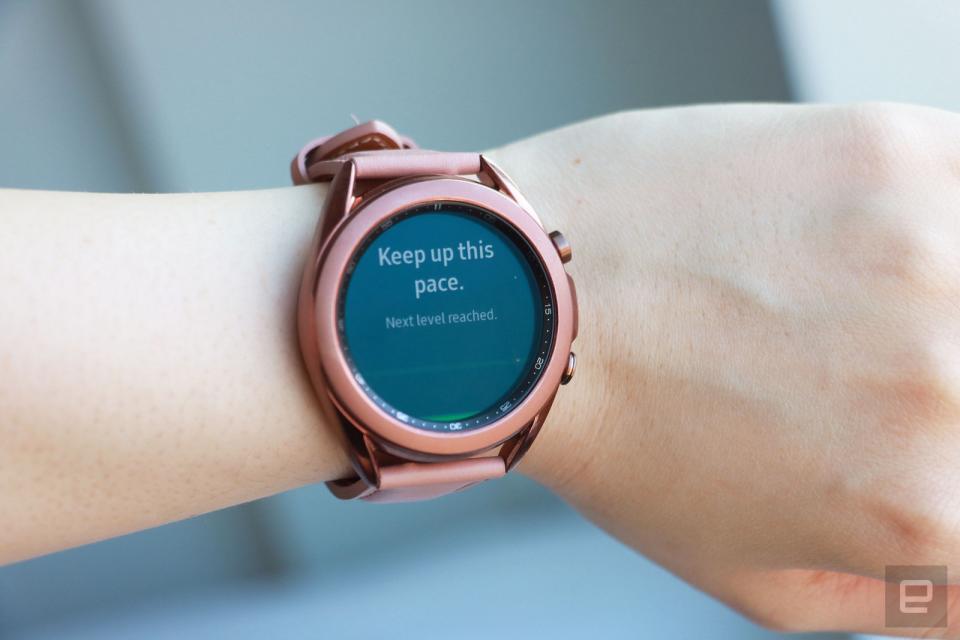
One of the updates that I could try was the new running coach. Samsung is not the first company to provide real-time audio and visual feedback on your jog, but the latest wearables from Apple, Fitbit and Garmin don’t. Plus, Samsung is doing it for free, which is rare. Fitbit’s Coach service requires a subscription fee, for example.
After selecting a goal from options like “light running,” “calorie burning” and “speed endurance,” you can start your run. In “light” mode, I was guided through four stages at gradually increasing speeds. The watch buzzed and told me to either slow down or speed up to hit the targets. When I met and stayed within the recommended range, the coach would tell me I was doing well, with on-screen graphics to match.
Every so often, too, the watch would say things like “Great pace, keep up this pace,” or “Think positively, you’re getting closer to your goal with every step.” It’s meant to be encouraging but, when delivered in its very robotic voice, it feels a little creepy. Plus, sometimes it would say weird things like, “Can you feel yourself working hard? What does it feel like?” and “Are you feeling well enough for exercise today?” That last one made me wonder if the watch detected some kind of anomaly and that maybe I shouldn’t work out, but it was just asking an impersonal question, not making a targeted observation.
The Watch 3 shows more comprehensive analysis for runs than for other workouts. In addition to the usual average heart rate, session duration and calories burned, you’ll see feedback on your symmetry, contact time, flight time, stiffness and regularity, with advice on what areas you need to improve. You’ll get more guidance like suggested drills and charts showing your cadence and pace when you view your session in the Samsung Health app on your phone. I’m not a hardcore runner so this information isn’t super useful to me, but exacting athletes will likely appreciate the extra data.
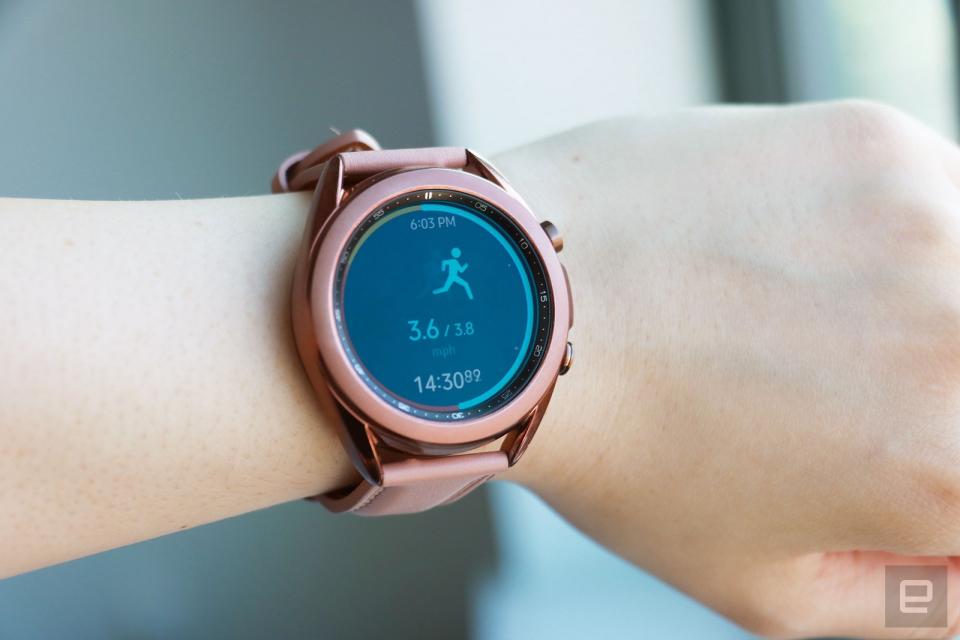
I may not be an expert in exercising but I’m basically an Olympic gold medalist when it comes to sleeping. Samsung updated the Watch 3’s sleep tracking to use the heart rate monitor and accelerometer data. This is a very similar approach to Fitbit, and uses the info to estimate how much time you spent in zones like REM, light sleep or deep sleep. It can also log how much time you spent awake. Samsung will assign you a score after tallying the time you spent asleep and also monitoring other factors like restlessness.
I had a terrible night drifting in and out of sleep before being awakened at 6:45 AM by a delivery person. When I looked at my watch later, I was unsurprised to see the Watch 3 had recorded four separate sleep sessions for the night, each period corresponding with times I had woken up. I don’t know all the exact times, but the watch accurately matched one instance when I remember noticing the sun was beginning to rise. Samsung scored each of these sessions between 30 and 40 (out of 100), which makes sense since they were all only about an hour long.
According to the watch, I barely spent any time in the restorative “deep sleep” zone, instead mostly hanging around light and REM sleep. There’s no real way to tell if Samsung is accurate in detecting these zones, but the Watch 3 so far matches my experience. With this, Samsung joins Fitbit in offering more insight on your sleep than Apple, even with the watchOS 7 beta that has yet to publicly roll out. The Apple Watch will log the amount of time you were asleep and note interruptions, but won’t tell you what zones you were in, which would paint a better picture of sleep quality.
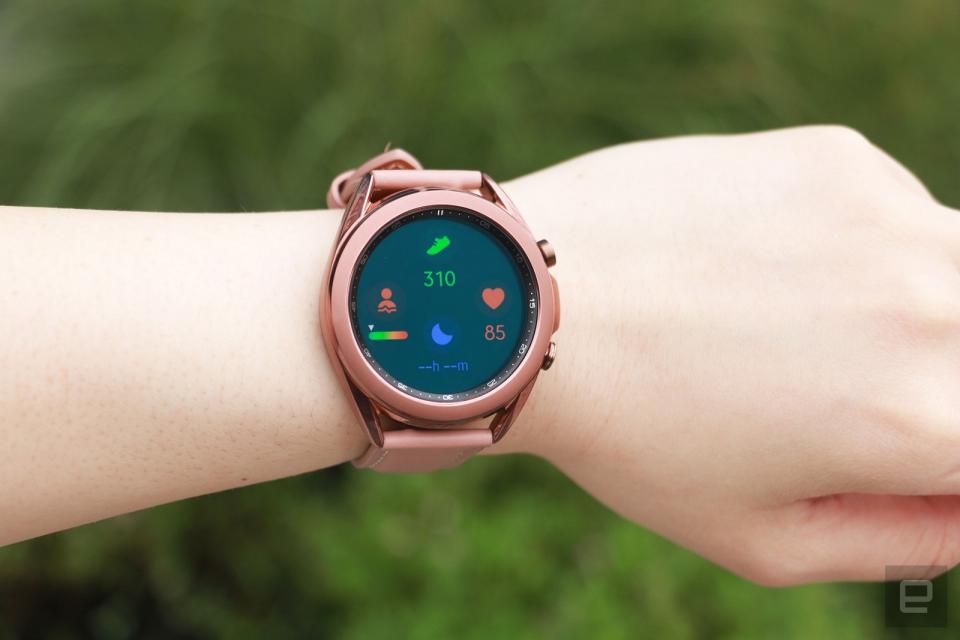
Your overall wellbeing isn’t just about exercise and sleep. Tizen OS health-tracking continues to outshine Wear OS and Fitbit OS. It offers helpful widgets for logging your food and water intake, and while I’m dubious on the accuracy of its stress-tracking tool, it at least offers some guided breathing exercises to help you relax. I especially like that when the Watch 3 notices you haven’t moved in an hour, it’ll not only prompt you to get up and move, but also suggest some easy exercises you can do at your desk. Plus, when I accepted one of these recommendations and did a set of five torso twists, the Watch gave an onscreen graphic of how to do the action and tracked every single rep accurately. No other smartwatch offers this.
I like a lot of things about Samsung’s software, but I wish its heart rate monitor were faster. It takes 10 to 13 seconds to deliver a reading, at which point impatience has seemingly driven my pulse up. This could also affect its ability to keep up when monitoring your cardio zones during a workout. That said, it’s worth clarifying that, for obvious reasons, I wasn’t able to constantly keep an eye on the watch while exercising. In contrast, the Fitbit Versa 2 and the Apple Watch generally take about five seconds to produce a reading.
Blood oxygen readings and fall detection
Although Samsung added some new tools to make the Watch 3 a more robust fitness companion, it still feels better suited for more casual users than competitive athletes. New stats like VO2Max give more insight into your body’s performance during a workout, while blood oxygen (SpO2) readings are sometimes called the “fifth vital” metric by which to assess your health. (The first four are your pulse, temperature, blood pressure and respiratory rate.) These are helpful in specific circumstances but not of much use to the average person.
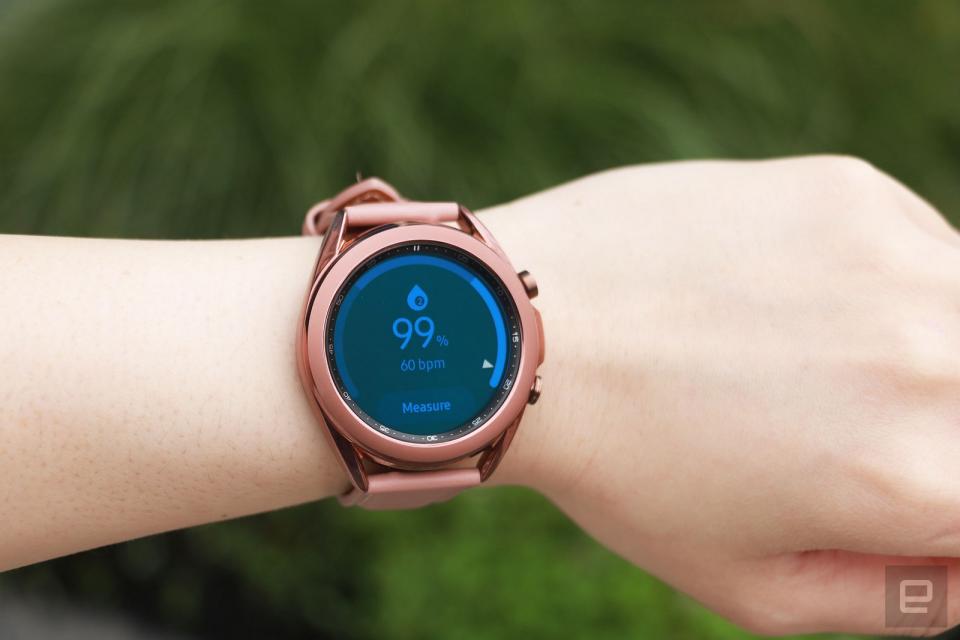
Samsung just released a software update that allows you to get SpO2 readings on the Watch 3, and I saw results between 98 and 99 percent. The Watch 3 interface showed me that this was on the extreme right end of a spectrum, but there was no other way to understand what that meant. Was I healthy? How did I rank against other people my age and gender? I always appreciate more data, but I had to go to Google to make sense of it. Thankfully, my result is typical (above 95 percent is normal, and you should see a doctor if you get something lower).
The Galaxy Watch 3 also offers a feature that we first saw on an Apple Watch: trip detection. It’s basically Apple’s fall detection, except Samsung went with a different name. The Galaxy Watch 3 will notice if you’ve fallen while you’re in motion, not when you’re still, and it will send an SOS message with your location to up to four designated contacts.
I deliberately hurled myself onto a yoga mat a few times, but never triggered the system. I even fell a couple times during my workouts, but the Watch 3 didn’t register them, possibly because I was tracking my exercise. I can’t safely test this feature to see if it will work in life-threatening situations, but at least you don’t have to wait till the Watch 3 determines you’ve fallen to get help. You can also push the home button on the side three times to call your emergency contacts and share your location with them.
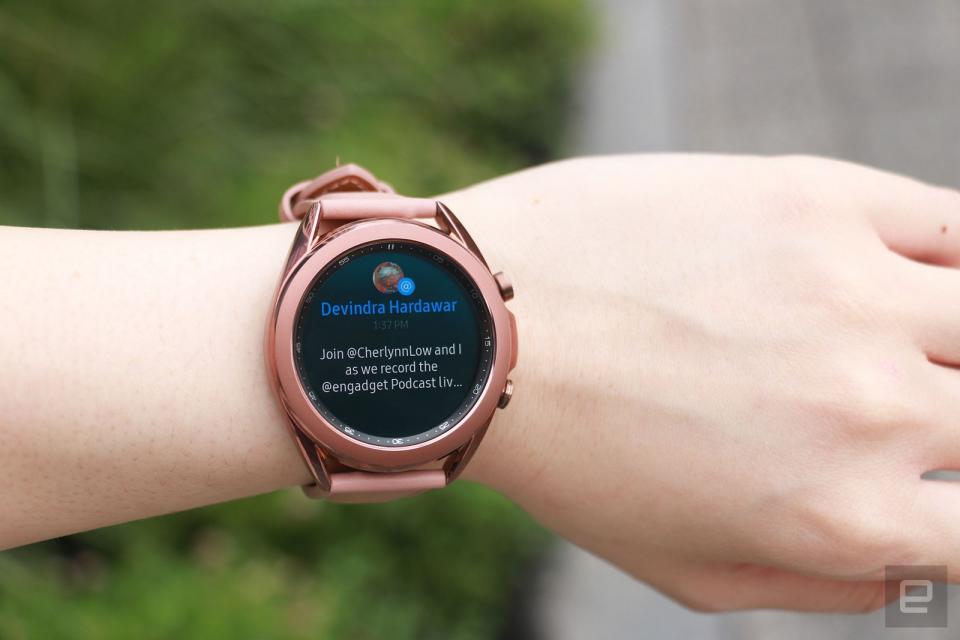
As a smartphone companion
One of Samsung’s smartwatch strengths, at least against competitors like Fitbit and Garmin, is how it syncs with your phone. Tizen is far better equipped at handling things like replying to messages, controlling your music, summoning an Uber or controlling your smart home than the Versas and Vivoactives.
When you receive a message, the Watch will show some of the earlier exchange so you can get some context for your conversation. Pictures in messages also show up in the notifications, something Fitbits and Garmins don’t offer. If you want to, you can also use the Samsung watch to call your friends. The onboard mic is decently clear and the speakers are loud enough that you can hear them over some light background noise.
Samsung also added new gestures in the experimental Labs section of the Wear app on your phone. When you enable these, you can theoretically dismiss or answer calls when wearing the Watch 3 by opening and clenching your fist. This didn’t work well at all during my tests; none of the actions registered, and the one time something happened the watch detected the wrong action and answered a call instead of rejecting it.
The Watch 3 has a few bugs and is missing some features, too. There’s no Qwerty-style swipe keyboard for composing messages like in previous Galaxy Watches. The Spotify controller was also finicky; it would skip and pause my music but refused to change the song title or album art on the watch. That second issue was fixed after Spotify updated its mobile app, though.
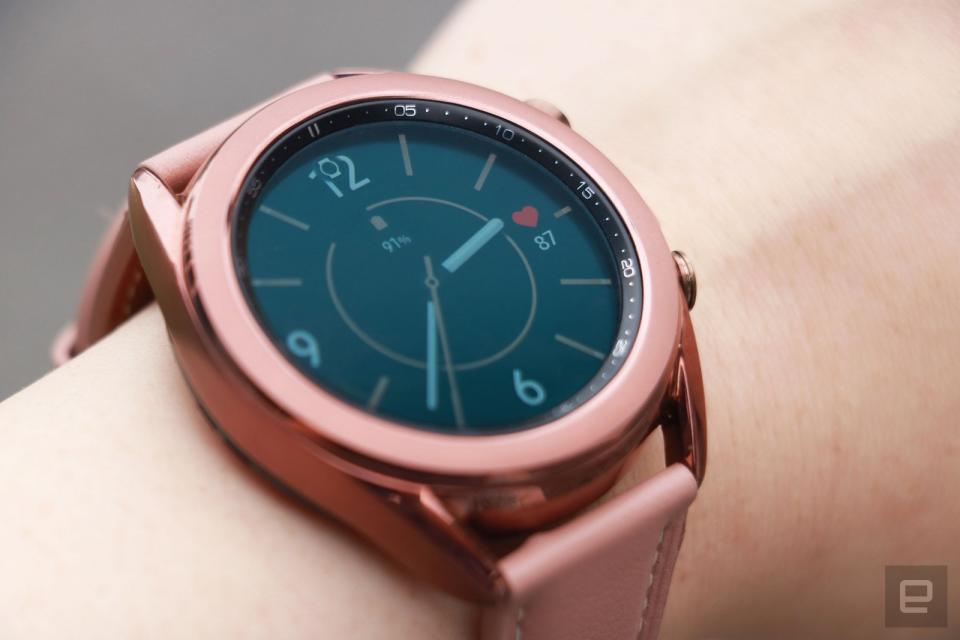
Battery life
The Galaxy Watch 3 consistently lasts about two days before running out of juice, offering a few hours extra if I didn’t spend part of the day tracking a workout. That’s in line with the Watch Active and an improvement over the Watch Active 2. The original Galaxy Watch generally managed about four days with light use, though, while Fitbit’s and Garmin’s smartwatches can last five days or more. Samsung does beat its main competitor, though, as Apple Watches generally eke out between one and two days depending on usage patterns.
Samsung also offers a battery saving mode that turns the watch to a basic timekeeper and step tracker. When my Watch 3 was down to nine percent, I switched to Battery Saving and got close to another day out of it. This is useful when you’re out and don’t want to be left with a dead screen on your wrist, but don’t expect to get days of extra juice out of it. And if you’ve bought the LTE version, expect runtime to be shorter than on a non-cellular model.
Wrap-up
As of this writing the Galaxy Watch 3 was still missing some key features, like ECG and blood pressure monitoring. But even without those, Samsung has a winner here. The Galaxy Watch 3 offers improved sleep tracking and comprehensive monitoring of various health metrics. Tizen OS is also better than Fitbits and Garmins at apps and syncing with your phone. If you’re considering an upgrade from a Galaxy Watch Active, know that you’ll mostly be paying more for that spinning bezel and upcoming ECG feature. For people on Android who aren’t looking for the niche insight and feedback from the likes of Garmin and Polar, the Watch 3 has a robust and well-rounded set of features. With the Galaxy Watch 3, Samsung easily holds onto the title of best smartwatch for Android users, an honor it’s held for the past two years.
Key specs
| Samsung Galaxy Watch 3 |
|---|---|
Processor | Exynos 9110 |
RAM | 1GB |
Internal storage | 8GB |
Display | 1.2-inch (41mm model; 1.4-inch on 45mm) Always On Display with Gorilla Glass DX |
OS | Tizen OS 5.5 |
Charging | WPC-based wireless charging |
Dimensions | 45mm: 45 x 46.2 x 11.1 mm 41mm: 41 x 42.5 x 11.3 mm *measured without strap |
Weight | 45mm: 53.8g (Stainless Steel) / 43g (Titanium) |
Waterproofing | 5ATM + IP68 / MIL-STD-810G |
NFC | Yes, Samsung Pay |
Battery | 45mm: 340mAh / 41mm: 247mAh |
